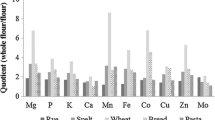Abstract
Samples of soft wheat flour (n=78), durum wheat semolina (n=6), and pasta (made from durum wheat, n=49) were purchased in January-April 2006 from retail outlets in Hesse, Germany. Samples were analysed for deoxynivalenol (DON) by enzyme immunoassay. The detection limit of the method was 10 μg/kg, with recoveries of 81–85% (RSDr: 12–17%). DON was detected in 84% of all samples, but the contamination level was low. Median/maximum values for DON in wheat flour, wheat semolina, and pasta were 28μg/kg/217 μg/kg, 38μg/kg/203 μg/kg, and 24μg/kg/119 μg/kg, respectively. Compared with results obtained from previous years, significantly lower DON levels were observed in these commodities.
Similar content being viewed by others
Literatur
European Commission (2003) SCOOP, task 3.2.10. Collection of occurrence data of Fusarium toxins in food and assessment of dietary intake by the population of EU Member States. European Commission, Directorate-General Health and Consumer Protection, Reports on tasks for scientific co-operation, April 2003. http://europa.eu.int/comm/food/fs/scoop/task32 10.pdf
European Commission; Scientific Commitee on Food (2002) Opinion of the Scientific Committee on Food on Fusarium toxins. Part 6: Group evaluation of T-2 toxin, HT-2 toxin, nivalenol and deoxynivalenol. http://europa.eu.int/comm/food/fs/sc/scf/out123_en.pdf
Bundesministerium für Verbraucherschutz, Ernährung und Landwirtschaft (2004) Verordnung zur Änderung der Mykotoxin-Höchstmengen-verordnung und der Diätverordnung. BGBI I 2004 I, Nr. 5, 151–152
Europäische Kommission (2005) Verordnung (EG) Nr. 856/2005 der Kommission vom 6. Juni 2005 zur Änderung der Verordnung (EG) Nr. 466/2001 in Bezug auf Fusarientoxine Amtsblatt der Europäischen Union L 143, 3–8
Majerus P, Curtui V, Otteneder H, Usleber E (2002) Deoxynivalenol in Lebensmitteln: Ergebnisse einer Pilotstudie. Mycotoxin Research, 18A: 32–34
Schollenberger M, Müller HM, Drochner W (2002) Fusarium toxins in different food samples. Mycotoxin Research, 18A: 39–42
Schmidt S, Thielert G (2001) Fusarientoxine (DON und ZEA) in Mehl und Brot. Mycotoxin Research, 17A: 49–52
Curtui V, Brockmeyer A, Dietrich R, Kappenstein O, Klaffke H, Lepschy J, Märtlbauer E, Schneider E, Seidler C, Thielert G, Usleber E, Weber R, Wolff J (2005) Deoxynivalenol in Lebensmitteln, Mycotoxin Research, 21: 83–88
Europäische Kommission (2006) Verordnung (EG) Nr. 401/2006 der Kommission vom 23. Februar 2006 zur Festlegung der Probenahmeverfahren und Analysemethoden für die amtliche Kontrolle des Mykotoxingehalts von Lebensmitteln. Amtsblatt der Europäischen Union L70, 12–34
Author information
Authors and Affiliations
Corresponding author
Rights and permissions
About this article
Cite this article
Curtui, V., Seidler, C., Schneider, E. et al. Untersuchungen zu DON-Gehalten in Getreideerzeugnissen aus dem deutschen Einzelhandel im Jahr 2006. Mycotox Res 22, 170–173 (2006). https://doi.org/10.1007/BF02959271
Issue Date:
DOI: https://doi.org/10.1007/BF02959271




